Analysis of the 1974 Topps Baseball Card Set
Introduction: A Year of Transition and Intrigue
The 1974 Topps baseball card set stands as a pivotal release in the history of the hobby, marking a significant departure from previous production methods while introducing elements that would shape card collecting for decades to come. Released amidst Hank Aaron's historic home run chase and featuring a strong rookie class headlined by Hall of Famer Dave Winfield, the set is perhaps most famous for its unique production variations tied to the near-relocation of the San Diego Padres. This report provides a comprehensive analysis of the 1974 Topps set, examining its structure, key players, design elements, notable errors and variations, associated subsets, and enduring collector significance. It represents a fascinating intersection of baseball history, printing anomalies, and hobby evolution.
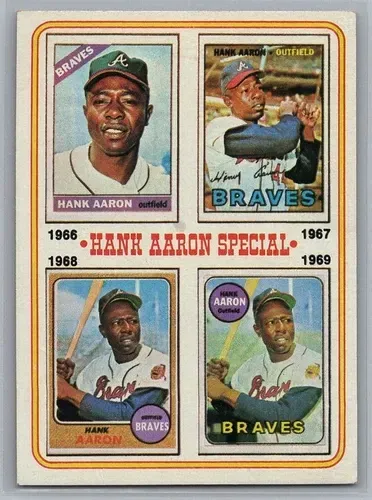
Set Fundamentals: The End of an Era in Distribution
The 1973 Topps baseball set comprises 660 standard-size cards, representing a significant reduction from the 787 cards issued in the 1972 set. This smaller set size, the most compact Topps baseball issue of the 1970s, resulted in fewer cards dedicated to lesser-known players and a reduction in the number of subsets compared to the previous year.
Critically, 1973 marked the final year Topps employed its long-standing practice of releasing baseball cards in multiple series throughout the season. The set was issued in five distinct series, each containing 132 cards. As was customary with multi-series releases, the final series, encompassing cards #529 through #660, was printed and distributed in smaller quantities. These "high numbers" are consequently scarcer and more challenging for collectors to acquire, particularly in high-grade condition. This scarcity directly influences the market value of cards within this range, most notably the Mike Schmidt rookie card (#615) and the final series checklist (#588). While the entire high-number series is less common, the term "short print" isn't typically applied to specific cards within the 1973 set in the same way it was used in earlier vintage issues; rather, the scarcity applies to the series as a whole.
The cessation of multi-series distribution after 1973 represented a fundamental shift in the baseball card landscape. For decades, collectors had engaged in the seasonal pursuit of later series cards, a defining characteristic of the vintage era. The move to single-series releases starting in 1974 standardized availability across the checklist from the beginning of the season, altering collecting habits and the nature of scarcity itself. The 1973 Topps set, therefore, stands as a significant historical marker, representing the conclusion of a defining production and distribution methodology and bridging the gap between distinct eras of baseball card collecting.
Set Fundamentals: Breaking from Tradition
The 1974 Topps baseball set comprises 660 cards, maintaining the standard size established in previous years but representing a continuation of the slightly smaller set size compared to the early 1970s. Each card measures the customary 2-1/2 inches by 3-1/2 inches.
The most groundbreaking aspect of the 1974 release was its distribution method. For the first time since Topps began issuing multi-card sets in 1952, the company released all 660 cards simultaneously at the beginning of the year, rather than staggering them in multiple series throughout the baseball season. This strategic shift was reportedly made to prevent Topps' late-season baseball series from competing directly with the release of its popular football card set in the fall, a period when baseball card sales typically experienced a decline. Topps highlighted this change directly on the wax pack wrappers, proclaiming, “All 660 cards in one series!”.
This move to a single-series release fundamentally altered the collecting experience. The traditional challenge and excitement of chasing scarce "high number" cards, common in previous Topps sets issued in multiple series , was eliminated for the base set. While simplifying the process of completing the 660-card base set compared to prior years, this change marked the end of an era for vintage collectors accustomed to the tiered scarcity inherent in multi-series distributions. It signaled a move towards a more standardized production model that would become the norm.
Furthermore, 1974 saw another Topps innovation: the first-ever factory-sealed complete set offered for sale. These sets were available exclusively through the JC Penney department store catalog. While factory sets would eventually become a hobby staple, this initial experiment was apparently not a major commercial success, as Topps did not offer another baseball factory set until the early 1980s. These early factory sets are now highly sought after by collectors.
Design and Aesthetics: A Snapshot of the Mid-70s
The design of the 1974 Topps cards presents a clean, if somewhat conventional, look for the era. Card fronts feature color photographs of the players, ranging from posed portraits to action shots. The player's name, team affiliation, and position are typically displayed in banners along the top and bottom edges of the card. While considered a solid design and perhaps an improvement over the 1973 set by some collectors , it lacked the bolder graphic elements seen in sets like 1971 (black borders) or 1972 (psychedelic frames).
Key design elements include:
- Photography: A mix of portrait and action photography is used. Some collectors find the photography less inspired than in other 70s sets, while others appreciate the focus on the player image.
- Borders: Simple white borders frame the photograph.
- Information: Player name, team, and position are clearly indicated on the front, often within colored banners that vary by team.
- Card Backs: Card backs are printed horizontally and feature biographical information, year-by-year and career statistics, and a player cartoon. The cartoons, a beloved feature for many young collectors of the era, were drawn by a specific artist who contributed to multiple Topps sports sets that year, giving them a distinct, whimsical style. These cartoons often provided trivia or personal insights about the player.
- Special Features:All-Star cards (#331-339) have a unique design element: their backs combine to form a picture puzzle of Bobby Bonds, the MVP of the 1973 All-Star Game. Consequently, these card backs lack player statistics.
- Manager & Coaches cards continue the format used in 1973, featuring a larger photo of the manager with smaller inset photos of the team's coaches below.
The overall aesthetic reflects the straightforward design trends of mid-1970s sports cards, prioritizing clear player identification and statistical information, complemented by the popular cartoon element on the reverse.
1974 Topps Set Overview
| Feature | Details |
|---|---|
| Set Size | 660 cards |
| Series Structure | Single Series (First time for Topps flagship baseball) |
| Card Dimensions | Standard 2-1/2" x 3-1/2" |
| Key Rookies | Dave Winfield (HOF), Dave Parker (HOF), Ken Griffey Sr., Bucky Dent, Frank Tanana |
| Key HOFers | Hank Aaron (Tribute), Nolan Ryan, Johnny Bench, Tom Seaver, Reggie Jackson, Mike Schmidt (2nd Yr), Willie Stargell, Lou Brock, Brooks Robinson, etc. |
| Notable Subsets | Hank Aaron Special (#1-6), League Leaders (#201-208), All-Stars (Puzzle Back, #331-339), World Series (#472-479), Rookie Prospects (#596-608) |
| Key Variations/Errors | Washington "Nat'l Lea." (15 cards), Freisleben RC (#599, 3 versions), Aaron #1 UER, Kaline #215 UER, Berra MGR #179 UER |
| Associated Sets | Topps Traded (44 cards), Red Team Checklists (Inserts), Topps Stamps (Test), Topps Deckle Edge (Test) |
Hall of Famers and Stars: Anchoring the Set
Despite the shift in distribution, the 1974 Topps set remained packed with star power, anchored by a special tribute to one of baseball's biggest icons and featuring numerous other Hall of Fame players.
- Hank Aaron Tribute: The set famously opens with a six-card subset (#1-6) dedicated to Hank Aaron, anticipating his imminent breaking of Babe Ruth's all-time home run record. Aaron had finished the 1973 season with 713 home runs, just one shy of the record.Card #1 boldly proclaims Aaron as the "New All-Time Home Run King". This is technically an Uncorrected Error (UER), as Aaron did not hit his record-breaking 714th home run until April 1974, after the cards were printed. This lead-off card is known to be challenging to find in high-grade condition.
- Cards #2 through #6 serve as a visual retrospective of Aaron's career, showcasing collages of his previous Topps cards from distinct eras: 1954-57 (#2), 1958-61 (#3), 1962-65 (#4), 1966-69 (#5), and 1970-73 (#6).
- Constellation of Stars: Beyond the Aaron tribute, the checklist reads like a who's who of baseball legends from the era. Prominent Hall of Famers featured include Nolan Ryan (#20), Johnny Bench (#10), Tom Seaver (#80), Reggie Jackson (#130), Willie Stargell (#100), Lou Brock (#60), Brooks Robinson (#160), Frank Robinson (#55), Harmon Killebrew (#?), Bob Gibson (#?), Steve Carlton (#95), Gaylord Perry (#35), Catfish Hunter (#7), Fergie Jenkins (#87), Phil Niekro (#29), Joe Morgan (#85), Willie McCovey (#250 - including the Washington variation), Juan Marichal (#330T - in the Traded set), Rod Carew (#50), Carlton Fisk (#105), and Bert Blyleven (#98). The set also includes the popular second-year card of future Hall of Famer Mike Schmidt (#283).
- Final Farewells: The 1974 Topps set marks the end of an era for several legendary players, featuring the final regular-issue Topps cards depicting Hall of Famers Luis Aparicio (#61), Orlando Cepeda (#83), and Al Kaline (#215) during their playing careers. The Al Kaline card (#215) is noted as an uncorrected error by some sources, potentially missing a copyright line on the back.
The Celebrated 1974 Rookie Class
While the set boasts numerous established stars, its rookie card lineup provides significant long-term value and collector interest, led by a cornerstone Hall of Famer.
- Dave Winfield (#456): The Crown Jewel: The undisputed king of the 1974 rookie class is Dave Winfield. His card (#456) is the sole Hall of Fame rookie card in the base set and is widely considered his most important and desirable card. Notably, in an era where multi-player rookie cards were common (even for stars like Mike Schmidt in 1973 or George Brett in 1975), Winfield was granted a solo rookie card, enhancing its visual appeal and collector focus. Despite speculation fueled by the Padres' potential move, it is crucial to note that no "Washington Nat'l Lea." variation exists for the Dave Winfield rookie card. While not considered exceptionally rare in terms of population, the Winfield rookie is condition-sensitive, often found with centering issues or minor print defects (like print snow) on the card front, making high-grade examples particularly valuable.
- Dave Parker (#252): "The Cobra" Debuts: Another future Hall of Famer making his debut in the 1974 set is Dave "The Cobra" Parker. His rookie card (#252) is a key card in the set and highly sought after by collectors of Pirates legends and Hall of Fame rookies.
- Other Notable Rookies: Beyond the two Hall of Famers, the set includes the rookie cards of several other significant players:
- Ken Griffey Sr. (#598 - featured on the "Rookie Outfielders" card).
- Bucky Dent (#606 - featured on the "Rookie Shortstops" card).
- Frank Tanana (#599 - featured on the "Rookie Pitchers" card, subject to the Washington variation discussed later).
- Bill Madlock (#?).
- Other rookies appearing on the multi-player "Rookie Prospects" cards or as solo cards include John Grubb (#32), Gary Thomasson (#18), Bill Campbell (#26), Dick Ruthven (#47), and Randy Jones (#173 - including the Washington variation).
- Rookie Prospects Subset Format: Cards numbered #596 through #608 comprise the "Rookie Prospects" subset. Unlike Winfield's solo card, these feature four players each, grouped by position (e.g., Rookie Pitchers, Rookie Catchers, Rookie Outfielders, etc.). This format was common for Topps rookie cards during this period.
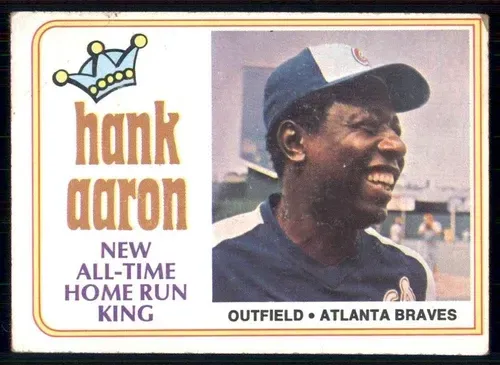
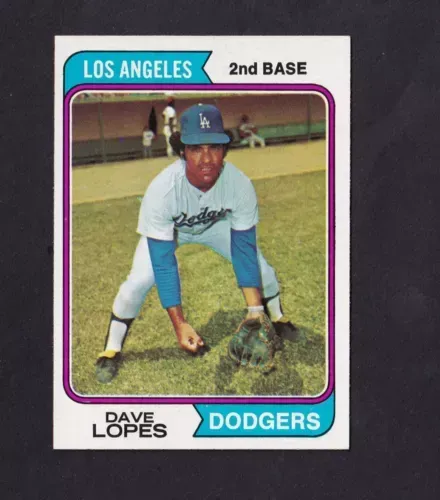
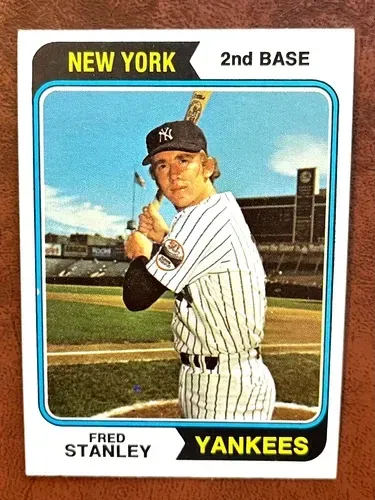
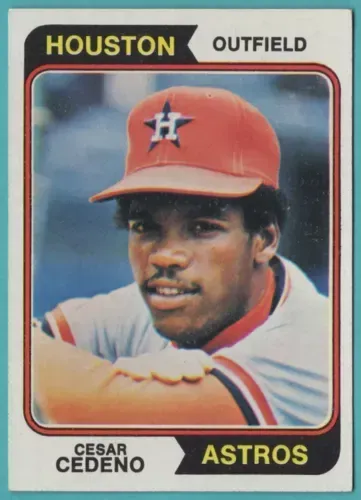

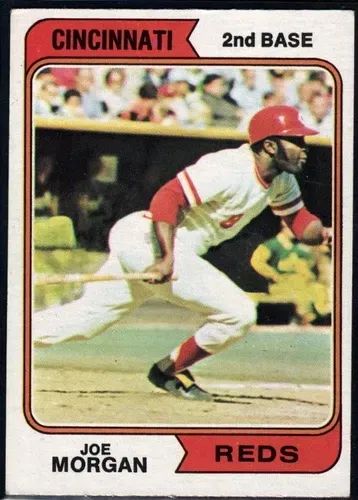
Exploring the Subsets: Beyond the Base Cards
The 1974 Topps set includes several thematic subsets interspersed throughout the 660 cards, offering collectors focused mini-collections within the larger set.
Key Subsets in the 1974 Topps Set
| Subset Name | Card Numbers | Description / Notable Feature |
|---|---|---|
| Hank Aaron Special | #1-6 | Career retrospective/collage anticipating HR record; Card #1 is UER |
| League Leaders | #201-208 | Standard statistical leaders from the 1973 season |
| All-Stars | #331-339 | AL/NL stars selected from 1973; Backs form a puzzle of Bobby Bonds (1973 ASG MVP), lack player stats |
| Playoff Highlights | #470-471 | Highlights from the 1973 League Championship Series |
| World Series Highlights | #472-479 | Key moments from the 1973 World Series (Oakland A's vs. New York Mets) |
| Rookie Prospects | #596-608 | Four prospects per card, grouped by playing position |
| Team Cards | Scattered | Standard team photos |
| Manager & Coaches | Scattered | Combined card format with large manager photo and smaller coach insets |
These subsets add thematic depth to the set, commemorating achievements like Aaron's pursuit of the home run record, recognizing league leaders and All-Stars, and chronicling the previous postseason. The unique puzzle back feature on the All-Star cards provides an added interactive element for collectors.
Innovation Spotlight: The Inaugural Topps Traded Set
Perhaps as significant as the move to a single-series release was the introduction of the first-ever Topps Traded set in 1974. This supplementary set addressed a long-standing issue for collectors: players being depicted with teams they no longer played for due to offseason or early-season trades that occurred after the main set went to press.
Specifically designed to feature players who changed teams in late 1973 (primarily December trades), the Traded set provided updated cards for collectors seeking accurate team representation. The set consists of 44 cards: 43 player cards and one unnumbered checklist card. These cards were inserted into regular 1974 Topps wax packs towards the end of the production run and were also included as a bonus with the JC Penney factory sets. Despite being inserts, they were produced in large quantities and are generally not considered scarcer than the regular base cards.
The Traded cards have a distinct design:
- Fronts: Feature player headshots, often utilizing airbrushing to depict the player in their new team's cap or jersey. A prominent "TRADED" banner runs across the top or bottom.
- Backs: Employ a unique newspaper-article style format, providing details about the trade that necessitated the updated card.
- Numbering: Cards use the same number as the player's card in the main 1974 set, but with a "T" suffix (e.g., Ron Santo is #270 in the base set and #270T in the Traded set).
Notable players featured in the inaugural Traded set include Hall of Famers Ron Santo (#270T), Juan Marichal (#330T), and Willie Davis (#165T), along with other popular players like Lou Piniella (#390T), Jim Wynn (#43T), and Felipe Alou (#485T).
The creation of the Traded set was a significant development. It acknowledged the dynamic nature of player movement and provided a mechanism for Topps to offer updated, more accurate cards later in the season. This innovation laid the groundwork for the Topps Traded and Update series that would become staples of the hobby in the 1980s and beyond, satisfying collector demand for completeness and timeliness. Combined with the single-series release, the Traded set signaled a clear shift towards the structure of modern baseball card sets.
Errors and Variations: The Curious Case of the Washington "Padres"
The 1974 Topps set is indelibly linked to one of the most famous and widely collected variations in hobby history: the "Washington Nat'l Lea." cards. This anomaly stemmed directly from real-world baseball business events.
- The Core Story: Throughout 1973 and into early 1974, it was widely expected that the financially struggling San Diego Padres franchise would be sold and relocated to Washington D.C. for the 1974 season. The move appeared so certain that by the time Topps needed to finalize artwork and begin printing its 1974 set (likely in late 1973), the company made a calculated decision.
- Topps' Gamble: Topps printed cards for players on the Padres roster designating their team as "Washington" and the league as "Nat'l Lea.".
- The Kroc Intervention: The anticipated move dramatically fell through in late January 1974 when McDonald's founder Ray Kroc purchased the team with the specific intention of keeping it in San Diego.
- Production Scramble & Correction: By the time Kroc saved the Padres for San Diego, Topps had already printed a substantial number of sheets featuring the incorrect "Washington" designation. Scrapping these printed sheets was deemed prohibitively expensive. Topps quickly moved to correct the printing plates, changing the team designation back to "San Diego Padres" for the remainder of the print run.
- The Resulting Variations: This mid-production correction resulted in 15 specific cards (13 individual players, the Padres team card, and one multi-player rookie card) existing with both the incorrect "Washington Nat'l Lea." version and the corrected "San Diego Padres" version. The "Washington" versions, having been printed for a shorter duration before the correction, are the scarcer and more valuable variations. The existence of these variations, born from external business dealings and Topps' reaction, highlights how real-world events can create unintentional hobby rarities that captivate collectors due to their backstory and scarcity.
1974 Topps Washington "Nat'l Lea." Variation Checklist
| Card # | Player Name | Notes (Position/Team Card/HOF/Rookie) | Relative Scarcity of Wash. Var. |
|---|---|---|---|
| 32 | Johnny Grubb | RC, OF | More Common |
| 77 | Rich Troedson | RC, P | More Common |
| 102 | Bill Greif | P | More Common |
| 125 | Nate Colbert | 1B | More Common |
| 148 | Dave Hilton | INF | More Common |
| 173 | Randy Jones | P | More Common |
| 197 | Vicente Romo | P | More Common |
| 226 | Padres Team Card | TC | More Common |
| 241 | Glenn Beckert | INF | More Common |
| 250 | Willie McCovey | HOF, 1B | More Common |
| 312 | Dave Roberts | P | Scarcer |
| 364 | Cito Gaston | OF | Scarcer |
| 387 | Rich Morales | INF | Scarcer |
| 599 | Rookie Pitchers (Freisleben/Diorio/Riccelli/Shanahan) | RC, P (Dave Freisleben is the Padre) | Wash=Most Common |
| 599 | Rookie Pitchers (Freisleben/Diorio/Riccelli/Shanahan) | RC, P (Dave Freisleben is the Padre) - SD Padres Large Font | SD Large Font = Scarcer |
| 599 | Rookie Pitchers (Freisleben/Diorio/Riccelli/Shanahan) | RC, P (Dave Freisleben is the Padre) - SD Padres Small Font | SD Small Font = Rarest |
| Export to Sheets |
Note: Scarcity tiers based on sheet distribution theory suggesting cards #32-250 were on earlier sheets with more Washington versions printed before correction, while #312-387 were on later sheets corrected sooner. Card #599 has its own unique variation sequence.
- The Freisleben Anomaly (#599 Rookie Pitchers): The multi-player "Rookie Pitchers" card (#599), featuring Padres prospect Dave Freisleben, presents a unique and complex variation situation. This card was located on one of the later printing sheets (along with Dave Winfield's card) that were believed to have been corrected before major printing began. However, during the proofreading process to change "Washington" back to "San Diego," the Freisleben card was overlooked. This oversight led to three distinct versions of card #599:
- Washington Nat'l Lea.: The initially printed, incorrect version. Ironically, because the error was caught relatively late on this sheet, this "Washington" version is the most common of the three #599 variations.
- San Diego Padres (Large Font): After the error was noticed, Topps hastily corrected the card to "San Diego Padres." However, this first correction used a noticeably larger font size for the team name than was used on other rookie cards in the set. This version is scarcer than the Washington version.
- San Diego Padres (Small Font): Realizing the font discrepancy, Topps corrected the card again, this time using the smaller, standard font size consistent with other rookie cards. This final, truly correct version is the rarest of the three #599 variations.
- Winfield Confirmation: It bears repeating: Dave Winfield's rookie card (#456) was not affected by the Washington variations and exists only with the "San Diego Padres" designation.
- Other Documented Errors: Beyond the famous Washington saga, a few other uncorrected errors (UERs) are noted:
- #1 Hank Aaron: Incorrectly states "New All-Time Home Run King" before he broke the record.
- #179 Yogi Berra MGR/Coaches: Coach Eddie Yost's hometown misspelled "Hauppage" instead of "Hauppauge".
- #215 Al Kaline: Reportedly missing the copyright line on the back.
While minor print defects like spots or "snow" are common across the set, particularly affecting cards like the Winfield rookie , the Washington variations and the few documented UERs are the primary points of interest for error collectors.
Associated Sets and Test Issues
In addition to the base set and the groundbreaking Traded set, Topps produced several other related items in 1974, including inserts and test issues, reflecting a period of aggressive product experimentation. Collectors seeking a "master" collection of 1974 Topps often pursue these associated items:
- Red Team Checklists: These unnumbered cards feature facsimile autographs of team players within a red border on the front, with a team checklist on the back. They were inserted into 1974 Topps wax packs and were also available as uncut sheets through a wrapper redemption offer. The complete set consists of 24 cards, one for each MLB team at the time.
- Topps Stamps: Harkening back to earlier concepts, Topps tested baseball stamps again in 1974. The set featured 240 players. These stamps were sold in test-market wax packs containing 12 stamps each, often in generic white wrappers. Stamp albums were also produced for collectors to house them. The checklist included Hall of Famers like Aaron, Ryan, Seaver, Bench, and the Winfield rookie.
- Topps Deckle Edge: A particularly scarce and visually distinct test issue, these cards featured black-and-white photos with a die-cut "deckle" or jagged edge. Variations exist, including gray backs (GB) and white backs (WB), as well as versions with and without card numbers. The checklist included stars like Ryan, Seaver, Aaron, Gibson, Carlton, and Rose. Due to their scarcity, they command significant premiums.
- OPC (O-Pee-Chee): As was standard practice, Topps' Canadian counterpart, O-Pee-Chee, released its version of the 1974 set for the Canadian market, often featuring slight variations in card stock or text.
- Other Test Issues: Documentation suggests Topps also experimented with a Jigsaw Puzzle test issue and an Action Emblems (cloth sticker) test issue around this time, though these are exceptionally rare. This flurry of test products underscores Topps' efforts to innovate and find new revenue streams during a challenging economic period in the mid-1970s.
Collector Significance and Market Perspective
Fifty years after its release, the 1974 Topps baseball set remains a significant and popular issue among vintage collectors, valued for its historical importance, key cards, and unique quirks.
- Historical Importance: The set's place in hobby history is secured by its status as the first Topps baseball set issued in a single series, ending the era of high numbers for the flagship product. It also marked the first (albeit limited) release of a factory set and, crucially, the debut of the Topps Traded set concept. These innovations represent a clear transition point between vintage distribution methods and the more modern approaches that would follow.
- Collector Appeal: The set offers broad appeal. Star collectors are drawn to the deep checklist of Hall of Famers and the second-year Mike Schmidt card. Rookie card collectors target the key debuts of Dave Winfield and Dave Parker. Variation collectors are particularly intrigued by the famous Washington "Nat'l Lea." cards and the complex Freisleben rookie variations. For set builders, the single-series release makes the 660-card base set a more attainable goal than many earlier Topps issues. However, assembling a "master set" that includes all Washington variations, the Traded set, and potentially other inserts like the Red Team Checklists, presents a significant challenge and expense, illustrating the growing distinction between base and master set collecting that emerged in this era.
- Condition Sensitivity: As with all vintage cards, condition is paramount in determining value for 1974 Topps. Cards from this era are susceptible to common condition flaws. Centering is frequently imperfect, even on cards pulled directly from packs. Print defects, such as ink spots, roller marks, or "snow" (small white dots), can also detract from eye appeal and grade. Due to these factors, high-grade examples (typically PSA 8 NM-MT, PSA 9 Mint, and PSA 10 Gem Mint) of key stars, rookies, and especially the Washington variations command substantial premiums in the market.

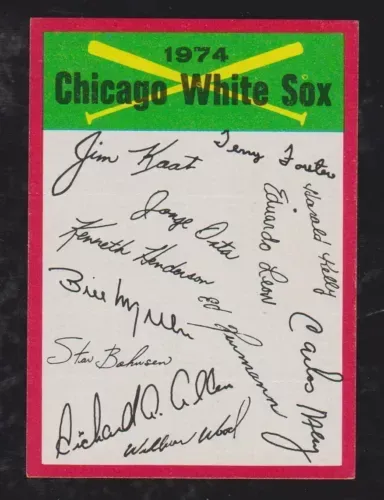
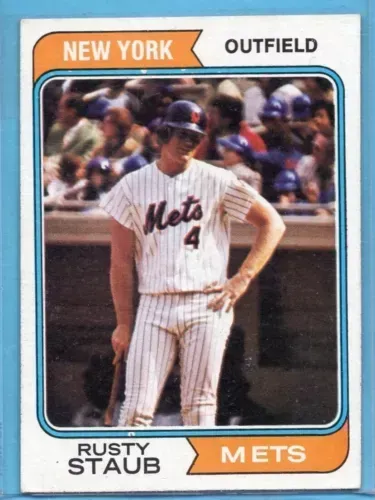
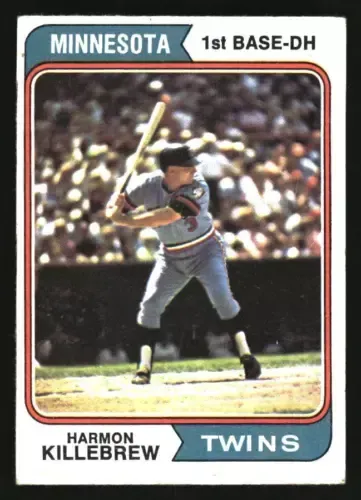
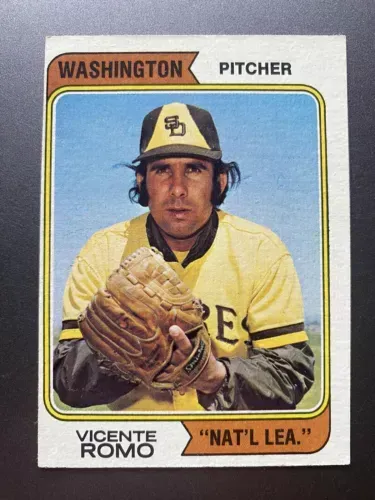
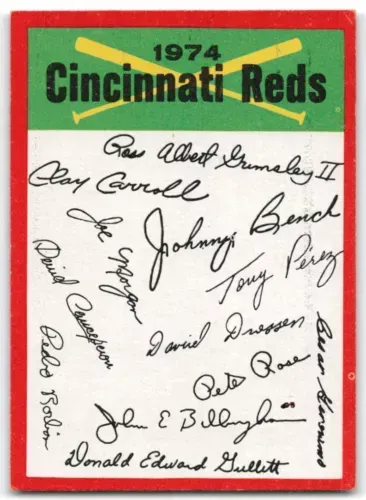
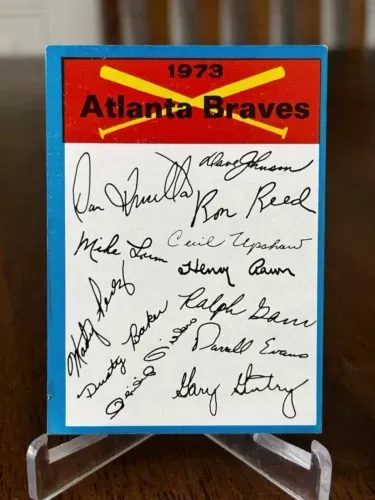
Conclusion: The Enduring Legacy of 1974 Topps Baseball
The 1974 Topps baseball card set occupies a unique and important position in hobby history. It successfully navigated Hank Aaron's pursuit of the home run record with a memorable tribute subset and introduced a landmark Hall of Fame rookie card in Dave Winfield, alongside the debut of fellow Hall of Famer Dave Parker.
However, its most enduring legacy lies in its structural innovations and production anomalies. As the first Topps set released all at once, it fundamentally changed the collecting landscape, eliminating the chase for high numbers that had defined previous decades. The simultaneous introduction of the first Traded set provided a template for future update releases, addressing the perennial issue of player movement.
And then there is the Washington variation saga. Born from the uncertainty surrounding the Padres' potential relocation, the 15 cards printed with the "Washington Nat'l Lea." designation stand as a testament to how real-world events can unexpectedly create hobby legends. The story behind these variations, coupled with their relative scarcity, makes them among the most sought-after error/variation cards of the 1970s.
Collectively, these elements—the single-series release, the debut of the Traded set, the strong player selection, and the unforgettable Washington variations—solidify the 1974 Topps set as a historically significant, challenging, and endlessly fascinating issue for baseball card collectors. It serves as a bridge between eras, closing the book on multi-series distribution while opening the door to modern set structures and the dedicated pursuit of variations and updates.
